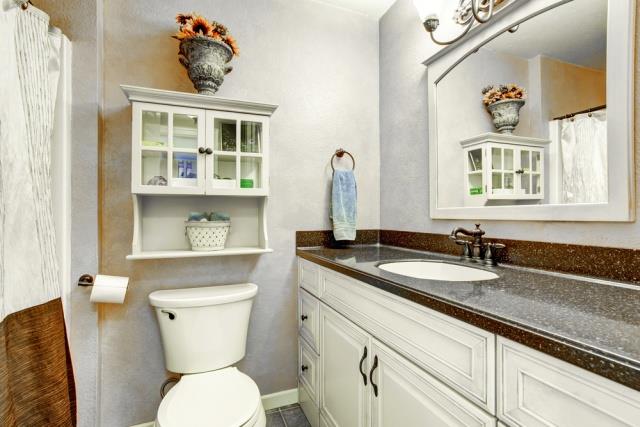This project is designed for those living in a rented home, where bathroom storage is always limited and the landlord is likely to have a fit if you drill into the walls.
This over-the-toilet storage project is designed to fit easily into any bathroom and, although you’ll be drilling into the grout, you can easily touch this up when you leave.
You will need
- 12mm SupaWood for the project, which is lightweight yet still offers enough strength
- Two 200mm x 1500mm boards for the sides
- Three 188mm x 510mm boards for the top, bottom and shelf
- Two 250mm x 600mm boards for the doors
- One 100mm x 534mm for bottom support
- Four small brass hinges
- Two plastic corner brackets
- Three 13mm wood screws
- Three 20mm wood screws
- Two handles
- Tape measure
- Pencil
- Prominent Paints acrylic sheen (broken white or white)
Tools
- Bosch Drill/driver and assorted drill and screw bits
- Countersink bit
- 220-grit sandpaper
- Foam roller and paint tray
- Small paintbrush
- Bosch PDO Multi Electronic detector
Here’s how
1. Working on a flat, level surface, place the top section between the two sides. Hold it firmly or clamp it down so you can drill 2mm pilot holes and countersink the holes.
Drive three 20mm screws through both sides into the top section.
2. Measure 300mm from the top on both sides (front and back) and draw a line. This is where you’ll mount the shelf.
Once again, hold or clamp the shelf in place as you drill 2mm pilot holes, countersink and drive in three 20mm screws.
3. Measure down 600mm from the top on both sides (front and back) and mark as the position for the bottom shelf. Note that the shelf must be mounted on top of the line so that it lines up with the bottom of the doors that are still to be fitted.
4. Position the doors over the cabinet and measure 30mm from the top and mark on the door and side frame for mounting the top hinges. Repeat this at the bottom of the door, measuring 30mm up.
5. Place the top of the hinge against the top mark, with the barrel (or pin) of the hinge hanging over the edge, then mark the position of the holes with a pencil. Drill 2mm pilot holes and drive in the 13mm screws to attach the hinges.
DIY tip
When attaching the hinges, note that the board is 12mm thick and the screws are 13mm long. Be careful not to drive the screws too hard as they will damage the other side of the board.
6. Sand all the edges down using a 220-grit sandpaper before applying two to three coats of Prominent Paints acrylic sheen in broken white.
Use a small paintbrush to get into corners. Allow sufficient drying times between coats and use a foam roller for a brush stroke-free, smooth finish.
7. Mark the position for the door catches on the back of each door. Use 13mm screws to attach.
8. Also mark the position for door catches on the bottom shelf. These catches should overlap the edge of the shelf by 3mm to allow for the thickness of the hinges. Use 13mm screws to attach.
9. Mark each door at 300mm. On the handles, measure the distance between the screw holes and transfer this onto the door, using the centre line as a guide for correct positioning. Attach handles.
10. Use a 3mm wood bit to drill the holes for the screws.
DIY Tip
Use a piece of scrap wood at the back where you’re drilling to reduce splitting of the wood.
Additional mounting
Use small plastic corner brackets to attach the cabinet to the wall. Position the brackets so that they can be screwed into the grouted area between tiles. Any holes can easily be concealed when you leave by filling in with grout.
Good to know
When drilling into walls, especially tiled walls, use a detector to scan the area to prevent drilling into pipes or electrical conduits.
Article courtesy of www.home-dzine.co.za.










